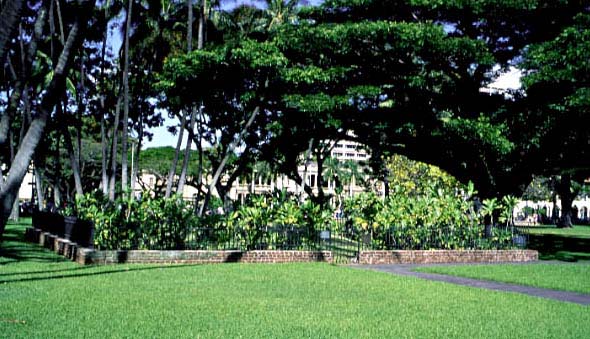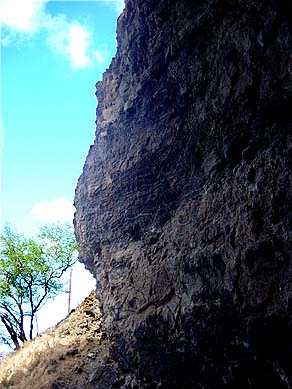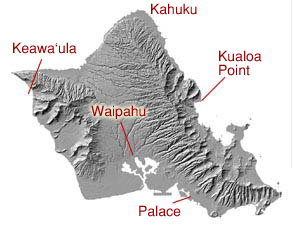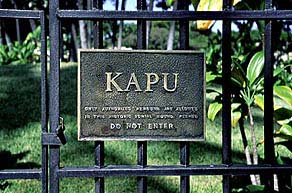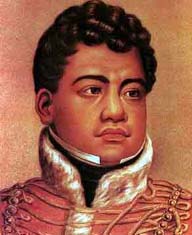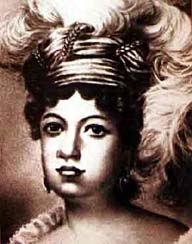 |
 |
 |
|||||||||||||||||||||
|
|
|
|
|
|
|
|
|
||||||||||||||||
|
|
|||||||||||||||||||||||
|
|
|
|
Pohukaina, former tomb of Hawaiian
kings and chiefs, on the grounds of ‘Iolani Palace.
|
|
|
"Pohukaina was apparently an ancient burial cave," Jim Bartels explains. "The greatest kings were buried in secret caves, and Pohukaina seems to be one of these, that went for a considerable distance underground. "Since the ancient kings were buried with their treasured possessions, this Pohukaina came to be thought of as a treasure house of all the wonders that a king would have -- feather work, and beautiful woodwork, and all these great treasures. The legend grew that Pohukaina was actually a series of caves with openings in different parts of the Island of O'ahu. The cave would have reached to all edges of the island."
|
||
|
|
||
"The cave is said to go completely under the island of O‘ahu" Puakea elaborates. "It has waterfalls, it has streams, it has really huge, high chambers and low chambers, and it’s manamana — it goes out into fingers of caves that go different places. There are supposed to be all different burial chambers within. "The main entry is on the grounds of ‘Iolani palace. Then there’s an entry to it in Kalihi, and there’s one in Moanalua. But the highest chamber under the island of O‘ahu is supposed to be under Konahuanui. So Konahuanui is called 'Kaupoko o ka hale,' the roof of the house. Not because it’s the highest mountain in the Ko‘olau range, but because it’s the highest chamber in the cavern, Pohukaina."
|
|
|
|
“Pohukaina extends out to Kualoa, up to Kahuku point, and over to Waipahu, a place named because of the water that burst forth there. It was a pounding spring. And some woman pounding kapa in Kahuku lost her kua, It fell into the water, ended up drifting through this cavern, and came out in Waipahu. So it showed the connection between all of these. "There was even said to be an entry out at Keawa‘ula, which is the far end of what is called Yokohama today, all the way at the end of the moku of Wai’anae. It’s supposed to connect into this. Kaneana cave in that district is supposed to have once tied into Pohukaina. It was also supposed to go all the way to Kaua‘i. But there are many accounts.”
|
|
|
|
|
|
"Pohukaina is on the makai-Waikiki corner of what is now the Palace grounds," Jim Bartels continues. "There is no real record of any settlement on that spot until the American missionaries arrive in town. The king separates them by putting them on the land of Kawaiha'o, which in the 1820s was a considerable distance from the small town of Honolulu. "Generally the Hawaiian chiefs live either in Waikiki, or in the
old town around Fort Street, and over towards Nu‘uanu Stream. But
the great lord Kalanimoku, who serves as something like a prime minister
under Queen Ka‘ahumanu and Kamehameha II, creates a large, fabulous
thatched palace, beautifully built, to be close to these wonderful teachers.
So he creates a royal compound on what is now Pohukaina, and maintains
that on his residence."
|
|
|
|
|
"King Kamehameha II and his favorite wife, Kamamalu, his half sister, went to Europe in 1823" Bill Maioho recounts. "They took retainers and other high chiefs -- Boki and Liliha, Kekuanaoa -- on the journey with them. While in England, they contracted the measles -- the whole group. "The Queen passes away, and nine days later, the King passes away, more from a broken heart than from his illness. He wasn’t as sick as the queen was; the other high chiefs and high chiefesses weren’t as ill also. But the king just gave up his ‘uhane, his spirit, because the loss of his favorite wife. "So King George IV, through his emissaries, had them placed in these beautiful mahogany caskets, and he chose Lord Byron, a cousin to the poet Byron, to transport the King and Queen back to Hawai‘i, along with the other high chiefs who had traveled with them. "Then upon their arrival in Hawai‘i, in consultation between the Kuhina Nui, Ka‘ahumanu, and other high chiefs, and telling them about Westminster Abbey and the underground burial crypts they had seen there, it was decided to build a mausoleum building on the grounds of ‘Iolani Palace."
|
|
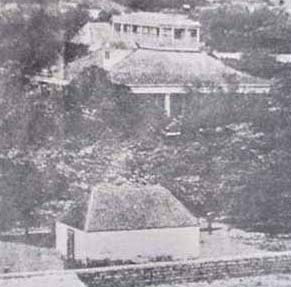
|
"Their beautiful caskets are brought and placed in Kalanimoku's complex," Jim Bartels continues the story. "And after a time, a small eighteen-by-twenty-four foot, Western style, coral structure in is built as a mausoleum. At that point, we begin to hear the name 'Pohukaina' spoken." "When Kamehameha II, this sacred person and his sacred sister, were buried in this earth, my belief is that the whole Pohukaina image was transferred there at that time. It seems that the name 'Pohukaina' begins at the time of their burial in 1825. "So that became the royal tomb from 1825 up until the 1860s, and as each king and his family died, their coffins were put in this little house. Problem is, you begin to realize that the house is too small, because we hear of high chiefs, and chiefs being buried there as well." "We believe that somehow, Kalanimoku had found a natural cave and built this little house on top of it," Jim concludes. "And then we know that the ali‘i who were not quite royal were buried in unmarked graves around the house. So that whole area in that quadrant of the Palace grounds, quite a large area, ended up being the chiefs' cemetery."
|
|
|
|
|
"In 1858, Kamehameha IV brings over the ancestral remains -- coffins and even earlier grave goods, going way way back -- and they are buried in Pohukaina. They got them out of the caves, which is a long tumultuous story, because the royal remains were considered god-like. Many aspects of the care of a chief's woven casket required what amounted to religious worship. So the great woven caskets or ka'ai of Liloa and Lono-i-ka-makahiki were brought to Pohukaina. "This is what gives the area a great sanctity, because these are some of the greatest chiefs who ever lived. When the new mausoleum was built in Nu‘uanu, the original house was torn down. The area was then just leveled, and a lawn planted over it. "When King Kalakaua was Europeanizing the ‘Iolani palace grounds, he put a French garden in that area. But he raised a simple mound of earth that is still there today. Later that mound was surrounded by a little fence. "But the ancient remains were largely left in place, and are believed to be there today. That's why Pohukaina is being rediscovered as a very sacred place."
|
|
|
|
|
Was there really a cave at Pohukaina? Stephen Kubota explains: "In the distant past, Waikiki and all the areas up to the Manoa valley were underwater, and there are massive limestone formations, unlike lava tubes which are of volcanic origin, these are of coral. Geologists call these 'karst' formations. It's a kind of geologic formation, with vast underground reservoirs, caves with fresh water but also saltwater coming in, and even fish making their way in from the ocean. There are stories of blind mullet in Mo‘ili‘ili, and many stories of underground springs. The place names are very revealing: Punahou is a spring. Waikiki is 'the spouting waters'." What of the name "Pohukaina"? Puakea tells us, "The land came to be called Pohukaina there, which gets translated as 'Pohu-ka-‘aina'– that 'the land is quiet and calm.' Remote from the hubbub of Waikiki, and from the roar of the sea."
|
||
|
|
||
|
Pohukaina thus forms a sacred place of considerable significance. And so too is its neighboring site, though for different reasons. ‘Iolani Palace remains an important site of the Hawaiian Kingdom, past and present.
|
||
| Language | Sources & Links |
| |
|
|

|
| Nu‘uanu Home | Map Library | Site Map | Hawaiian Islands Home | Pacific Worlds Home |
|
|
|||
| Copyright 2003 Pacific Worlds & Associates • Usage Policy • Webmaster |
|||
